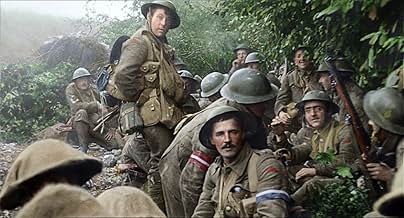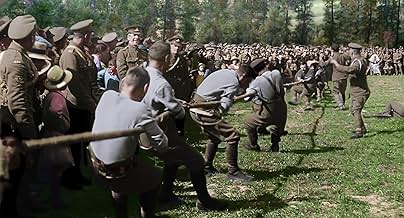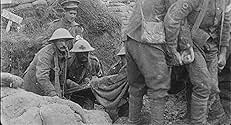VALUTAZIONE IMDb
8,2/10
39.889
LA TUA VALUTAZIONE
Un documentario sulla prima guerra mondiale con dei filmati mai visti prima per commemorare il centenario della fine della guerra.Un documentario sulla prima guerra mondiale con dei filmati mai visti prima per commemorare il centenario della fine della guerra.Un documentario sulla prima guerra mondiale con dei filmati mai visti prima per commemorare il centenario della fine della guerra.
- Nominato ai 1 BAFTA Award
- 6 vittorie e 14 candidature totali
Thomas Adlam
- Self - Bedfordshire Regiment
- (voce)
- (as Capt Thomas Adlam VC)
William Argent
- Self - Royal Naval Air Service
- (voce)
- (as LM William Argent)
John Ashby
- Self - The Duke of Cambridge's Own (Middlesex Regiment)
- (voce)
- (as Cpl John Ashby)
Attwood
- Self - British Army
- (voce)
- (as Cpl Attwood)
Walter Aust
- Self - East Yorkshire Regiment
- (voce)
- (as Pte Walter Aust)
Donald Bain
- Self - Seaforth Highlanders
- (voce)
- (as Pte Donald Bain)
Thomas Baker
- Self - Chatham Battalion, Royal Naval Division
- (voce)
- (as Pte Thomas Baker)
George Banton
- Self - 50th Division Headquarters
- (voce)
- (as Sig George Banton)
Walter Becklake
- Self - Northhampyonshire Yeomanry
- (voce)
- (as L Cpl Walter Becklake MM)
Arthur Beeton
- Self - Royal Navy Air Service
- (voce)
- (as POM Arthur Beeton)
Robert Bell
- Self - British Army
- (voce)
- (as Mr Robert Bell)
William Benham
- Self - Hawke Battalion, Royal Navy Division
- (voce)
- (as Sub Lt William Benham)
Joseph Biglin
- Self - Durham Light Infantry
- (voce)
- (as Pte Joseph Biglin)
Edwin Bigwood
- Self - Worcestershire Regiment
- (voce)
- (as Pte Edwin Bigwood)
Horace Birks
- Self - Tanks Corps
- (voce)
- (as Capt Horace Birks)
Edmund Blunden
- Self - Royal Sussex Regiment
- (voce)
- (as Lt Edmund Blunden MC)
Clarence Bourne
- Self - Army Service Corps
- (voce)
- (as S Sgt Clarence Bourne)
Allan Bray
- Self - The Duke of Edinburgh's ((Whiltshire Regiment))
- (voce)
- (as L Cpl Allan Bray)
Recensioni in evidenza
A century later, Peter Jackson produced an informative and fascinating documentary about the First World War, seen by the English, in the trenches of the Bay of Somme, with dusted and colored archive images.
Almost everyone expected a brief and victorious war, which, as it was said at the time, would be "over at Christmas". The continuation was very different and became a trench war. Hygiene was deplorable until it became laughable but the atmosphere within the troops was fraternal despite the constantly oppressive atmosphere.
And we also learn that the English infantrymen regularly had a mission to capture a Fritz. Knowing that from a military strategy point of view, this is a complete nonsense, a war prisoner being systematically an useless and cumbersome dead weight, it is perhaps a pity that this documentary does not give to the audience an explicit explanation. And the only rational explanation is probably this one: to force the English infantrymen to attack the Germans, the prisoner of war being the proof of the effectiveness of their attack ...
Almost everyone expected a brief and victorious war, which, as it was said at the time, would be "over at Christmas". The continuation was very different and became a trench war. Hygiene was deplorable until it became laughable but the atmosphere within the troops was fraternal despite the constantly oppressive atmosphere.
And we also learn that the English infantrymen regularly had a mission to capture a Fritz. Knowing that from a military strategy point of view, this is a complete nonsense, a war prisoner being systematically an useless and cumbersome dead weight, it is perhaps a pity that this documentary does not give to the audience an explicit explanation. And the only rational explanation is probably this one: to force the English infantrymen to attack the Germans, the prisoner of war being the proof of the effectiveness of their attack ...
Jackson's remarkable looking documentary is an amalgam of archive footage (much of it originally staged for the 1916 film 'The Battle of the Somme'), with only a tiny amount of actual battle footage given the early nature of film cameras in those days, plus the more moving sight of several of the soldiers staring and smiling into camera, and thanks to skillful lip-reading, speaking through interpreted voices.
The slowing down to our standard 24fps and adding of voices is beautifully touching. I personally don't know if it was essential to colourise as some of the greys in the originals are still visible, when uncolourised black and white footage is still just as immediate (the irony is that so many war films nowadays are drained of colour anyway.) Nonetheless, it is a vivid impression of life on the Western Front that Jackson helps to create, and remains refreshingly objective to its time, reflecting the general pro-war feelings at the beginning in 1914, and through carefully selected testimonies of the many hundreds of soldiers, unfolds the story of a kind of war that had never been seen before, or hopefully never will be again. Sadly humanity never learns its lesson, as the "war to end all wars" is now better known as World War I - all the more reason for history to remind us.
You watch this film, and in some of its more harrowing scenes you can see all the visual influence that Jackson drew upon for his Lord of the Rings trilogy. He dedicated this film to his grandfather who served in the war, and watching it , on the day after my own great grandfather's birthday (who also served in WWI), it was a thought provoking moment that stayed with me for a few hours after.
The slowing down to our standard 24fps and adding of voices is beautifully touching. I personally don't know if it was essential to colourise as some of the greys in the originals are still visible, when uncolourised black and white footage is still just as immediate (the irony is that so many war films nowadays are drained of colour anyway.) Nonetheless, it is a vivid impression of life on the Western Front that Jackson helps to create, and remains refreshingly objective to its time, reflecting the general pro-war feelings at the beginning in 1914, and through carefully selected testimonies of the many hundreds of soldiers, unfolds the story of a kind of war that had never been seen before, or hopefully never will be again. Sadly humanity never learns its lesson, as the "war to end all wars" is now better known as World War I - all the more reason for history to remind us.
You watch this film, and in some of its more harrowing scenes you can see all the visual influence that Jackson drew upon for his Lord of the Rings trilogy. He dedicated this film to his grandfather who served in the war, and watching it , on the day after my own great grandfather's birthday (who also served in WWI), it was a thought provoking moment that stayed with me for a few hours after.
"Trapped in a Charlie Chaplin World". So says director Peter Jackson in a post-screening discussion with Mark Kermode, describing early black and white documentary footage. Whereas modern film runs at 24 fps, most of the old footage is hand cranked, with speeds as low as 12 fps which leads to its jerky nature. Jackson in this project with the Imperial War Museum took their WW1 footage and put it through a 'pipeline process. This cleaned-up and restored the original footage; used clever computer interpolation to add in the missing 6 to 12 frames per second; and then colourised it.
The results are outstanding. Jackson wisely focuses the film on the specific slice of WW1 action from the trenches. And those anonymous figures become real, live, breathing humans on screen. It is obviously tragic that some (and as commented by Jackson, many in one scene) are not to be breathing humans for much longer.
These effects take a while to kick in. The early scenes in the documentary are in the original black and white, describing the recruitment process, and how many of the recruits were under-age. (To explain the varied comments in the film, they should have been 18, although officially shouldn't have been sent overseas until 19).
It is when the troops arrive in France that we suddenly go from black-and-white to the fully restored and colourised footage, and it is a gasp-inducing moment.
All of the audio commentary is from original BBC recordings of war veterans recounting their actual experiences in the trench. Some sound like heroes; some sound like rogues; all came out changed men. Supporting music of WW1 ditties, including the incredibly rude "Mademoiselle from Armentières" over the end credits, is provided by Plan 9.
But equally impressive is the dubbing of the characters onscreen. Jackson employed forensic lip-readers to determine what the soldiers on-screen were saying, and reproduced the speech using appropriate regional accents for the regiments concerned. Jackson also recounts how the words associated with a "pep-talk" speech to troops by an officer he found on an original slip of paper within the regimental records: outstanding. Added sound effects include real-life shelling by the New Zealand army. It all adds to the overall atmosphere of the film.
The film itself is a masterpiece of technical innovation that will change in the future the way in which we should be able to see this sort of early film footage forever. As a documentary it's near-perfection. But if I have a criticism of the cinema showing I attended it is that the 3D tended to detract rather than add to the film. Perhaps this is just my eyesight, but 3D always tends to make images slightly more blurry. Where (like "Gravity") there are great 3D effects to showcase, it's worth the slight negative to get the massive positive. But here, there was no such benefit: 2D would have been better. For those in the UK (and possibly through other broadcasters worldwide) the film is being shown on BBC2 tonight (11/11/18) at 9:30: I will be watching it again to compare and contrast.
Jackson dedicated the film to his grandfather. And almost all of us Brits will have relatives affected by this "war to end all wars". In my case, my grandfather was shot and severely wounded at Leuze Wood on the Somme, lying in the mud for four days and four nights before being recovered... by the Germans! Fortunately he was well-treated and, although dying young, recovered enough to father my father - else I wouldn't be here today writing this. On this Rememberance Sunday, 100 years on, it is a time for us to truly remember the sacrifice these men and boys gave to what, all in the film agree, was a pretty obstinate and pointless conflict.
The results are outstanding. Jackson wisely focuses the film on the specific slice of WW1 action from the trenches. And those anonymous figures become real, live, breathing humans on screen. It is obviously tragic that some (and as commented by Jackson, many in one scene) are not to be breathing humans for much longer.
These effects take a while to kick in. The early scenes in the documentary are in the original black and white, describing the recruitment process, and how many of the recruits were under-age. (To explain the varied comments in the film, they should have been 18, although officially shouldn't have been sent overseas until 19).
It is when the troops arrive in France that we suddenly go from black-and-white to the fully restored and colourised footage, and it is a gasp-inducing moment.
All of the audio commentary is from original BBC recordings of war veterans recounting their actual experiences in the trench. Some sound like heroes; some sound like rogues; all came out changed men. Supporting music of WW1 ditties, including the incredibly rude "Mademoiselle from Armentières" over the end credits, is provided by Plan 9.
But equally impressive is the dubbing of the characters onscreen. Jackson employed forensic lip-readers to determine what the soldiers on-screen were saying, and reproduced the speech using appropriate regional accents for the regiments concerned. Jackson also recounts how the words associated with a "pep-talk" speech to troops by an officer he found on an original slip of paper within the regimental records: outstanding. Added sound effects include real-life shelling by the New Zealand army. It all adds to the overall atmosphere of the film.
The film itself is a masterpiece of technical innovation that will change in the future the way in which we should be able to see this sort of early film footage forever. As a documentary it's near-perfection. But if I have a criticism of the cinema showing I attended it is that the 3D tended to detract rather than add to the film. Perhaps this is just my eyesight, but 3D always tends to make images slightly more blurry. Where (like "Gravity") there are great 3D effects to showcase, it's worth the slight negative to get the massive positive. But here, there was no such benefit: 2D would have been better. For those in the UK (and possibly through other broadcasters worldwide) the film is being shown on BBC2 tonight (11/11/18) at 9:30: I will be watching it again to compare and contrast.
Jackson dedicated the film to his grandfather. And almost all of us Brits will have relatives affected by this "war to end all wars". In my case, my grandfather was shot and severely wounded at Leuze Wood on the Somme, lying in the mud for four days and four nights before being recovered... by the Germans! Fortunately he was well-treated and, although dying young, recovered enough to father my father - else I wouldn't be here today writing this. On this Rememberance Sunday, 100 years on, it is a time for us to truly remember the sacrifice these men and boys gave to what, all in the film agree, was a pretty obstinate and pointless conflict.
Everyone over the age of 13 should be made to watch this.
This is simple exceptional work at every level from Peter Jackson and his team.
It showed the pure fragility of life, and how the soldiers dealt with it, mainly with humour and machine gun boiled tea.
It's haunting yet funny, disturbing yet uplifting. It's war. And this is the closest I ever want to come to it.
This is simple exceptional work at every level from Peter Jackson and his team.
It showed the pure fragility of life, and how the soldiers dealt with it, mainly with humour and machine gun boiled tea.
It's haunting yet funny, disturbing yet uplifting. It's war. And this is the closest I ever want to come to it.
Utterly haunting movie of life on the western front in WW1. Peter Jackson has thrown some serious computer firepower to bring these soldiers back to life.You will have never seen anything quite like this before.Breathtaking in many parts!
Lo sapevi?
- QuizMuch of the footage had never been seen, having sat in the vaults of London's Imperial War Museum for many years.
- BlooperSeveral shots of tanks appear in the film, both Mark V (Mark Five) and Mark V* (Mark Five Star). They have been colourised green. In reality, tanks of these types were painted "a neutral brown colour". See the article by the British Tank Museum which states that. "Surrendering to the inevitable, towards the end of 1916 it was ordered that the tanks should be painted in a 'neutral brown colour' all over." These tanks entered service in 1918, and were factory-painted brown.
- Citazioni
Soldier: [waving at camera] Hi, mum.
- Curiosità sui crediti"Filmed on location on the Western Front, 1914 to 1918"
- ConnessioniFeatured in Front Row: Episodio #3.3 (2018)
I più visti
Accedi per valutare e creare un elenco di titoli salvati per ottenere consigli personalizzati
- How long is They Shall Not Grow Old?Powered by Alexa
- When will this be on general release for the public?
- Is the title of this film an intentional misquote of Laurence Binyon's Ode of Remembrance?Laurence Binyon's poem 'For the Fallen' published in 1914 has the line "They shall grow not old" which is often misquoted as "They shall not grow old". Is Peter Jackson's film title playing with the meaning here, in the sense that we are seeing the soldiers as they were during the war, and therefore will not grow old on screen? Or is it another example of a misquote?
- will this be released on 3d bluray ?
Dettagli
- Data di uscita
- Paesi di origine
- Siti ufficiali
- Lingua
- Celebre anche come
- They Shall Not Grow Old - Per sempre giovani
- Luoghi delle riprese
- Aziende produttrici
- Vedi altri crediti dell’azienda su IMDbPro
Botteghino
- Lordo Stati Uniti e Canada
- 17.956.913 USD
- Lordo in tutto il mondo
- 21.656.913 USD
- Tempo di esecuzione1 ora 39 minuti
- Colore
- Mix di suoni
- Proporzioni
- 1.33 : 1(original footage)
- 1.85 : 1
Contribuisci a questa pagina
Suggerisci una modifica o aggiungi i contenuti mancanti

Divario superiore
What is the Hindi language plot outline for They Shall Not Grow Old - Per Sempre Giovani (2018)?
Rispondi


















